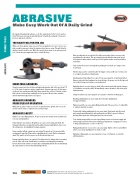Page 544 - CAT4
P. 544
ABRASIVE
Make Easy Work Out Of A Daily Grind
As manufacturing materials advance, so do the requirements for the tools to work on them. This means new speeds and attachments to handle the demands of increased precision and waste reduction.
THE RIGHT TOOL FOR THE JOB
When selecting a grinder and accessories for your application, be sure to choose one with enough horsepower to drive the abrasive wheel you are using. This will allow the grinder’s speed to work for you. When the operator bears down on an under-powered tool, it slows the rpm output and reduces overall efficiency.
INDUSTRIAL GRINDERS
Sioux has a great selection of inline and right angle grinders with collet sizes from 1/4" to 1/2" & 3 mm – 8 mm for a variety of applications. Speeds range up to 25,000 rpm to get the job done quickly and efficiently. Some models offer a choice of throttle control that is most convenient and comfortable for the operator. We also have extended models that fit into tight, hard to reach places.
ABRASIVE GRINDERS
PRINCIPLES OF OPERATION
When wheels, pads or other accessories are attached to the spindle, the tool can be used to remove metal or composites in a variety of ways.
ABRASIVE SAFETY
Grinders can cause flying particles. Proper eye protection must be worn at all times by tools user and bystanders.
Under improper use and wear, Air grinders can cause serious injury and death. The following instructions are important and should be followed explicitly but cannot cover all contingencies. Good judgment is always required.
Using a grinder without a guard can cause injury. The grinder is to be operated with an appropriate guard at all times when a grinding wheel is used. Replace a damaged guard. The guard is to be the proper one for the wheel being used.
Damaged grinding wheels can explode. Check the wheel for damage before mounting, such as chips and cracks. Handle wheels carefully to avoid dropping or bumping. Protect wheels from extremes of temperature and humidity. Check wheels immediately after any unusual occurrence that may damage wheels.
Over speeding wheels can explode. Check the speed rating of the accessory or the speed printed on the wheel. This speed must be greater than the name plate speed of the grinder/sander and the actual speed of the grinder/sander as measured with a tachometer.
Unsecured work can move violently when grinding. Secure work; use clamps or vise to hold work.
Grinders may coast for a short time after the trigger is released. Be sure tool has come to a complete stop before setting it aside.
Grinding wheels that malfunction or spin off can cause injury. Be certain that all wheel, flanges, nuts and related equipment are in good shape, the proper ones for the type and size of wheel being used, and are securely fastened.
Exploding wheels can cause injury or death. If the normal sound of the grinder changes, or if it vibrates excessively, shut it off immediately, remove the wheel, and check speed with tachometer.
Unexpected starts can cause injury. Be sure actuator is off before hooking up air.
Breathing grinding dust can cause injury. Do not breathe grinding dust. Use approved mask.
Explosions and fire can cause injury. Only grind metals if the area is free of combustible or explosive materials or vapors.
Contact with rotating grinding wheels can cause injury. Keep hands and other body parts away from grinding wheels and sanding pads and disks to prevent cutting or pinching. Wear protective clothing and gloves to protect hands.
Tools starting unexpectedly can cause injury. Always remove tool from air supply and activate trigger to bleed air line before making any adjustments, changing accessories, or doing any maintenance or service on the tool.
Flying grinding wheels or accessories can cause injury. Tighten collet securely. Match wheel or accessory shaft diameter to chuck or collet.
Exploding or flying parts can cause injury. Do not use cut off wheels or router bits with die grinders.
544
SafetyPrecaution: Readandfollowallsafetyandoperationinstructions.
Warning: Face & eye protection must be worn while operating power tools, per ANSI B186.1.
ABRASIVE POWER TOOLS


